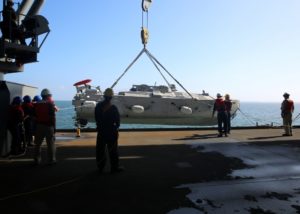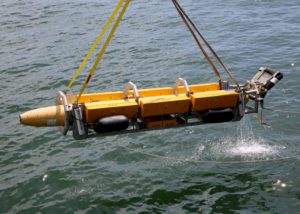The Navy tested a mine countermeasures (MCM) mission package (MP) on the expeditionary sea base USNS Hershel “Woody” Williams (T-ESB-4), the service said Sept. 19.
T-ESB-4 spent three days in the Chesapeake Bay, where it tested the Littoral Combat Ship (LCS) MCM mission package portable control station to maneuver the MCM equipment and the launch and recovery of equipment. The ship also tested the command and control of unmanned vehicles used in the MCM package.

According to released photos of the event, these tests occurred in mid-September.
The Navy said this test proved the ESBs can serve as an MCM-capable platform. The mission package includes 12 20-foot equivalent units, vehicles, and the support equipment to operate, launch, and recover one full MCM mission package. This includes the buried mine hunting and unmanned sweeping mission modules, with flexible ship modifications.
In June, Capt. Scot Searles, Strategic and Theater Sealift Program Manager at PEO Ships, said the service planned to experiment putting the LCS MCM mission package on expeditionary sea bases as a possible vessel of opportunity.
He said the ship is prewired with the right kinds of interfaces for MCM containers and can carry one or two packages so “we’re really bullish on the role of the ESBs…going forward” (Defense Daily, June 19).
The MCM aims to replace the Navy’s Avenger-class ships and MH-53E helicopters, which it expects to retire in the near future. The Navy plans to mostly use the MCM MP aboard LCSs, but reserved some units for vessels of opportunity, like T-ESBs.
“Mines of today are very inexpensive to make. Our adversaries can produce mines for a few hundred dollars and inflict a tremendous loss of life while causing millions of dollars of damage. So we need the assets out there to detect and destroy these threats ahead of time, and keep the world’s shipping lanes open,” Capt. David Gray, the USNS Hershel Woody William officer in charge, said in a statement.
The service said that initial assessments “showed positive results and will help inform the feasibility of integration on ESB, as well as other vessels of opportunity.”
Searles said this test shows the versatility of the ESB platform and how it can “bring capability to the fleet through expanded expeditionary warfare mission sets.”

“This demonstration highlighted the inherent modularity of the Mine Countermeasure Mission Package. The ability to deploy the MCM capability from this ship is a true force multiplier,” Capt. Godfrey Weekes, Littoral Combat Ships Mission Modules Program Manager, PEO Unmanned and Small Combatants (USC), added in a statement.
The Navy noted representatives from PEO Ships and PEO USC had overall responsibility for planning and execution of this integration test, supported by Naval Sea Systems Command’s Engineering Directorate, Naval Surface Warfare Center Panama City and Carderock Combatant Craft Divisions, and Mine Countermeasures Detachment 22.
Military Sealift Command personnel and ship’s force conducted ship operations, navigation, and maintenance of the ship systems during the demonstration.
The LCS MCM systems include the Textron [TXT] Common Unmanned Surface Vessel (CUSV) that tows systems like the unmanned surface sweep system and Raytheon [RTN] AQS-20 mine hunting sonar, General Dynamics’ [GD] Knifefish surface mine countermeasure unmanned underwater vehicle, Sikorsky [LMT] MH-60 helicopters equipped with the Northrop Grumman [NOC] AN/AES-1 Airborne Laser Mine Detection System (ALMDS) and Raytheon AN/ASQ-235 Airborne Mine Neutralization Systems (AMNS), and the Northrop Grumman MQ-8B Firescout unmanned helicopter.